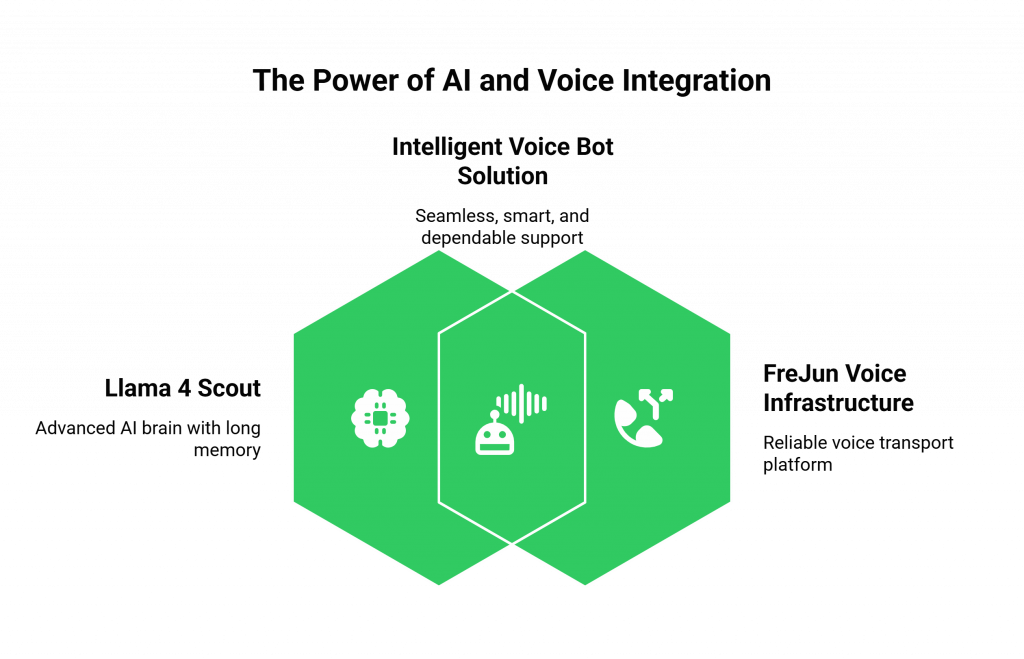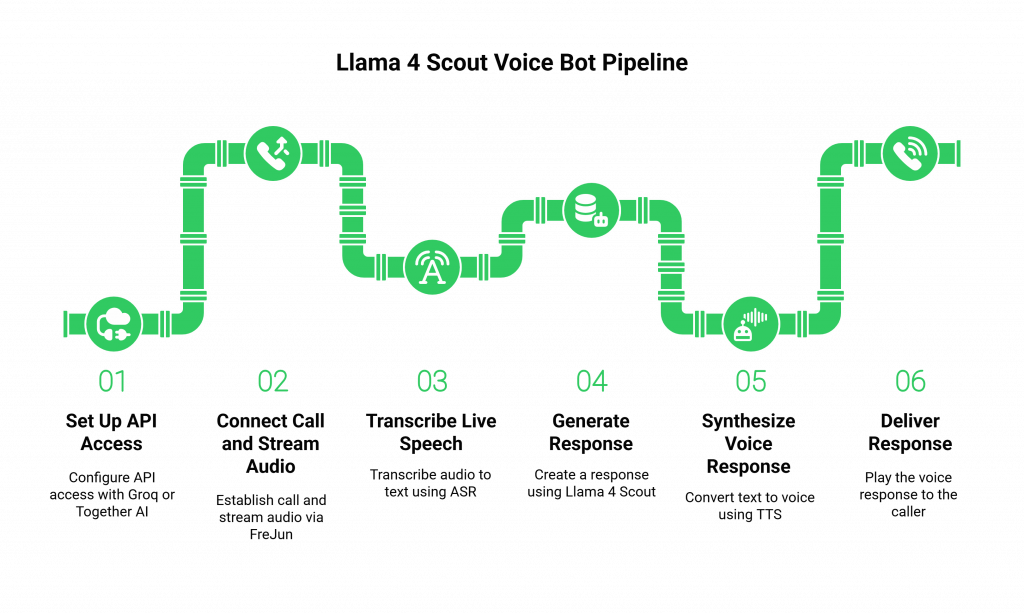For years, businesses building AI for customer support have been caught in a trilemma, forced to choose between three critical attributes: raw intelligence (power), real-time responsiveness (speed), and the ability to handle long, complex conversations (memory). Massive, dense models offered power but were slow and had limited context windows. Smaller models were fast but lacked intelligence and memory. This has been a major barrier to creating a single, unified AI agent that can truly handle the demands of modern customer service.
Table of contents
- The Production Wall: Where Voice AI Projects Go to Die
- The Solution: An Efficient Brain with a Long Memory and an Unbreakable Voice
- The Core Technology Stack for a Production-Ready Voice Bot
- The Production-Grade Llama 4 Scout Voice Bot Tutorial
- DIY Infrastructure vs. FreJun: A Strategic Comparison
- Best Practices for Optimizing Your Voice Bot
- From Efficient Model to Tangible Business Asset
- Frequently Asked Questions (FAQs)
This is where a new generation of AI, designed to solve this very trilemma, is changing the game. Meta’s Llama 4 Scout, with its innovative Mixture-of-Experts (MoE) architecture and a colossal 10-million-token context window, represents a breakthrough. It is both powerful and incredibly efficient, capable of running on a single GPU. It can also “remember” and reason over a conversation or document of virtually unlimited length. This unique combination finally makes it possible to build an AI agent that is smart, fast, and has a near-perfect memory.
The Production Wall: Where Voice AI Projects Go to Die
The excitement around a model like Llama 4 Scout is immense. Developers can build impressive demos that showcase its ability to analyze massive documents and hold a coherent conversation for hours. But a huge chasm separates this text-based demo from a scalable, production-grade voice bot that can handle live phone calls from real customers. This is the production wall, and it’s where most voice AI projects fail.
When a business tries to take their demo live, they collide with the brutal complexity of telephony infrastructure. The challenges are significant and often underestimated:
- Crippling Latency: The delay between a caller speaking and the bot responding is the number one killer of a natural conversation. High latency creates awkward pauses, interruptions, and a frustrating user experience.
- The Scalability Crisis: A system that works for one call will collapse under the weight of hundreds or thousands of concurrent calls during peak business hours.
- Infrastructure Nightmare: Building and maintaining a resilient, geographically distributed network of telephony carriers, SIP trunks, and real-time media streaming protocols requires highly specialized expertise, significant expense, and considerable time.
This infrastructure problem is the primary reason why so many promising voice AI projects stall, burning through budgets and engineering hours on “plumbing” instead of perfecting the AI-driven experience.
The Solution: An Efficient Brain with a Long Memory and an Unbreakable Voice
To build a voice bot that is smart, fast, and can remember, you need to combine an efficient, long-context AI “brain” with a robust, low-latency “voice.” This is where the synergy between Llama 4 Scout and FreJun’s voice infrastructure creates a powerful, production-ready solution.

- The Brain (Llama 4 Scout): As a state-of-the-art MoE model with a 10-million-token context window, Llama 4 Scout offers an unparalleled combination of efficiency and long-term memory, making it perfect for complex, in-depth customer support conversations.
- The Voice (FreJun): FreJun handles the complex voice infrastructure so you can focus on building your AI. Our platform is the critical transport layer that connects your Llama 4 Scout application to your customers over any telephone line.
By pairing Llama 4 Scout’s unique capabilities with FreJun’s reliability, you can bypass the biggest hurdles in voice bot development and create a genuinely intelligent support experience.
The Core Technology Stack for a Production-Ready Voice Bot
A modern voice bot is a pipeline of integrated technologies. For a bot powered by Llama 4 Scout, a production-ready stack includes:
- Voice Infrastructure (FreJun): The foundational layer that connects your bot to the telephone network, managing the call and streaming audio in real-time.
- Automatic Speech Recognition (ASR): A service like AssemblyAI or Whisper that transcribes the caller’s raw audio into text.
- Conversational AI (Llama 4 Scout): The “brain” of the operation, accessed via an API provider like Groq or Together AI, or your own private deployment.
- Text-to-Speech (TTS): A service like ElevenLabs or Google TTS that converts the AI’s text response into natural-sounding speech.
The Production-Grade Llama 4 Scout Voice Bot Tutorial
While many tutorials start with your computer’s microphone, a real business application starts with a customer’s phone call. This guide outlines the pipeline for a production-grade Llama 4 Scout voice bot.

Step 1: Set Up Your Llama 4 Scout API Access
Before your bot can think, its brain needs to be connected.
- How it Works: Choose a stable API provider like Groq or Together AI. Obtain your API key and configure your backend application (e.g., in Python using the groq library) to make authenticated requests.
Step 2: Connect the Call and Stream Audio via FreJun
This is where the real-world interaction begins.
- How it Works: A customer dials your business phone number, which is routed through FreJun. Our API establishes the call and immediately provides your application with a secure, real-time stream of the caller’s raw voice audio.
Step 3: Transcribe Live Speech with ASR
The audio stream from FreJun is fed directly to your chosen ASR engine.
- How it Works: You stream the audio from FreJun to your ASR service, which transcribes the speech in real time and returns the text to your application server.
Step 4: Generate a Response with Llama 4 Scout
The transcribed text is fed to your AI model.
- How it Works: Your application takes the transcribed text, appends it to the ongoing conversation history (leveraging the massive 10M token context window), and sends it all as a prompt to the Llama 4 Scout API. The model’s MoE architecture efficiently processes the input and generates a relevant, conversational reply.
Step 5: Synthesize and Stream the Voice Response with TTS
The text response from Llama 4 Scout must be converted back into audio.
- How it Works: The generated text is passed to your chosen TTS engine. To maintain a natural flow, it is critical to use a streaming TTS service that begins generating audio as soon as the first words of the response are available.
Step 6: Deliver the Response Instantly via FreJun
The final, crucial step is playing the bot’s voice to the caller.
- How it Works: You pipe the synthesized audio stream from your TTS service directly to the FreJun API. Our platform plays this audio to the caller over the phone line with minimal latency, completing the conversational loop and creating a seamless, interactive experience for your Llama 4 Scout voice bot.
DIY Infrastructure vs. FreJun: A Strategic Comparison
As you set out to build a Llama 4 Scout voice bot, you face a critical build-vs-buy decision for your voice infrastructure. The choice will impact your project’s speed, cost, and ultimate success.
| Feature / Aspect | DIY Telephony Infrastructure | FreJun’s Voice Platform |
| Primary Focus | 80% of your resources are spent on complex telephony, network engineering, and latency optimization. | 100% of your resources are focused on building and refining the AI conversational experience with Llama 4 Scout. |
| Time to Market | Extremely slow (months to over a year). Requires hiring a team with rare and expensive telecom expertise. | Extremely fast (days to weeks). Our developer-first APIs and SDKs abstract away all the complexity. |
| Latency Management | A constant and difficult battle to minimize the conversational delays that make bots feel robotic. | Engineered for low latency. Our entire stack is optimized for the demands of real-time voice AI. |
| Scalability & Reliability | Requires massive capital investment in redundant hardware, carrier contracts, and 24/7 monitoring. | Built-in. Our platform is built on a resilient, high-availability infrastructure designed to scale with your business. |
| Cost Efficiency | High fixed costs for hardware and specialized staff, regardless of call volume. | Pay-as-you-go model that scales with your usage, perfectly complementing the efficiency of the MoE model. |
Best Practices for Optimizing Your Voice Bot
Building the pipeline is the first step. To create a truly effective Llama 4 Scout voice bot, follow these best practices:
- Leverage the Massive Context Window: Don’t be shy about sending a detailed conversation history. Llama 4 Scout’s 10-million-token context window is its killer feature. Use it to provide unparalleled context for every single query.
- Use an Optimized API Provider: For real-time voice, the inference speed of your API provider is critical. Services like Groq are known for their high performance and are an excellent choice for a low-latency Llama 4 Scout voice bot.
- Master Prompt Engineering: Fine-tune your system prompts to clearly define the agent’s role, personality, and constraints. This is your primary tool for guiding its behavior.
- Test in Real-World Scenarios: Move beyond your development environment. Test your agent with real phone calls, diverse accents, and noisy backgrounds to ensure its robustness.
From Efficient Model to Tangible Business Asset
Llama 4 Scout is more than just another large language model; its unique architecture solves the long-standing trilemma of power, speed, and memory. This creates an unprecedented opportunity for businesses to deploy intelligent automation that is truly up to the task of modern customer support.
By building your Llama 4 Scout voice bot on FreJun’s infrastructure, you make a strategic decision to leapfrog the most significant technical hurdles and focus directly on innovation. You can harness the full potential of this groundbreaking model, confident that its voice will be clear, reliable, and ready to scale. Stop worrying about telephony and start building the future of your customer interactions. This is how you turn a powerful AI model into a tangible business asset.
Further Reading – Build an AI Voicebot with Full Backend Control
Frequently Asked Questions (FAQs)
Llama 4 Scout is a state-of-the-art, open-weight large language model from Meta. It stands out due to its efficient Mixture-of-Experts (MoE) architecture and its massive 10-million-token context window, making it both fast and capable of handling extremely long conversations.
No. FreJun is the specialized voice infrastructure layer. We provide the real-time call management and audio streaming. Our platform is model-agnostic, allowing you to connect to the Llama 4 Scout API from any provider like Groq or Together AI.
An MoE model is composed of multiple “expert” sub-networks. For any given input, the model only uses a small subset of these experts. This makes inference much faster and cheaper than a traditional dense model of a similar size.
A context window is the amount of text the model can “remember.” A 10-million-token window is enormous, allowing a Llama 4 Scout voice bot to process and recall information from a conversation or document that is thousands of pages long.
A business application needs to handle real phone calls from the public telephone network, scale to many concurrent users, and operate with high reliability and low latency. A microphone-based demo cannot meet any of these production requirements.
